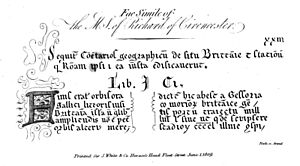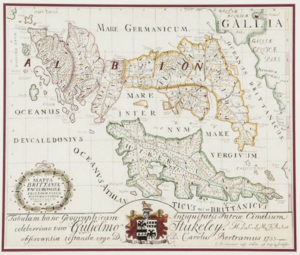Charles Bertram facts for kids
Quick facts for kids
Charles Julius Bertram
|
|
|---|---|
| Born | 1723 London, England |
| Died | 8 January 1765 Copenhagen, Denmark |
| Occupation | Academic Presumed forger |
| Nationality | Anglo-Danish |
| Notable works | Britannicarum Gentium Historiæ Antiquæ Scriptores Tres (The Description of Britain) |
Charles Julius Bertram (1723–1765) was an English person who lived in Denmark. He became famous for "finding" and probably writing The Description of Britain (Latin: De Situ Britanniae). This book was an 18th-century fake historical work that pretended to be a very old medieval text.
For over 100 years, no one realized it was a fake! It was very important for understanding the history of Roman Britain and ancient Scotland. Even famous historians like Edward Gibbon used it in his book Decline and Fall of the Roman Empire. It also helped guide William Roy when he started making the first Ordnance Survey maps of Britain. Bertram "found" this manuscript when he was about 24 years old. He spent the rest of his life as a successful scholar and writer. Even though some experts questioned parts of the Description, it wasn't officially proven to be a fake until 1846.
Contents
Early Life of Charles Bertram
Charles Bertram was born in London, England, in 1723. His father was an English silk dyer. Many people believed his father moved to Copenhagen, Denmark, with Princess Louisa. She was a daughter of King George II. Princess Louisa married Crown Prince Frederick of Denmark in 1743. (Prince Frederick became King Frederick V three years later.)
Other stories say Charles's father moved to Denmark earlier, in 1738. His father became a hosier (someone who sells socks and stockings) in 1744. Charles seemed to do well because the Danes welcomed Princess Louisa and her group. On July 5, 1747, Charles asked to study history, old objects, philosophy, and math at the University of Copenhagen. He was allowed to study there, even though students usually had to be part of the Danish Church, and Bertram remained Anglican.
He became friends with Hans Gram, who was the royal librarian. On March 23, 1748, Bertram asked the king if he could give public lessons on the English language. He became an English teacher at the Royal Marine Academy in Copenhagen. His 1749 book, An Essay on the Excellency and Style of the English Tongue, helped start English-language printing in Denmark.
The Fake History Book: The Description of Britain

In 1746, Bertram wrote a letter to William Stukeley, an English expert on old things. Bertram mentioned "a manuscript in a friend's hands of Richard of Westminster." This manuscript was supposedly a history of Roman Britain with an old map. Bertram later "admitted" that another Englishman had stolen it from an English library. He said he promised to keep it a secret.
Stukeley was very excited about this discovery. He asked Bertram to get the original manuscript, calling it "the greatest treasure we now can boast of." Bertram refused to sell the original to the British Museum. However, he sent Stukeley copies of the text and a version of the map. David Casley, who worked at the Cotton Library, said the writing looked about 400 years old. Stukeley trusted Bertram completely after this.
Stukeley studied the text for years. In 1756, he shared his findings with the Society of Antiquaries of London. He was thrilled that the text gave "more than a hundred names of cities, roads, people... which till now were absolutely unknown to us." He thought it was written "with great judgment."
In 1757, Bertram published the full text of The Description of Britain. He included it in a book with two other old texts. Bertram wrote in his introduction that the work "contains many fragments of a better time, which would now in vain be sought for elsewhere." He also noted that Dr. Stukeley thought it was "a jewel... worthy to be rescued from destruction."
Even though some parts of the text were questioned, no one doubted that the book itself was real for many decades. Bertram always had good reasons why the actual old document couldn't be shown. He just kept providing copies to anyone who asked.
Later Life and How the Forgery Was Discovered
Stukeley helped Bertram join the Society of Antiquaries of London in 1756. Bertram continued his work as an English teacher. His book, Royal English–Danish Grammar, was considered very good for its time. Charles Bertram died as a respected scholar in Copenhagen on January 8, 1765.
After Bertram's death, people tried to find the original manuscript in Copenhagen, but they couldn't. This made some people wonder if the book was real. In 1827, John Hodgson said the text was fake. He pointed out that it wasn't in Bertram's papers and had strange errors in its old-style writing.
By 1838, enough doubts had appeared that the English Historical Society decided not to include The Description of Britain in their list of important historical works.
The final proof that it was a fake came in 1846. A German scholar named Karl Wex was working on a new edition of Tacitus's Agricola, another ancient text. He noticed that The Description of Britain included mistakes that had been added to editions of Tacitus by printers in Venice in the late 1400s. This meant Bertram must have copied from a printed book, not an ancient manuscript!
Many British scholars were slow to accept the truth. But more evidence came out in the following years. By the 1860s, no one could seriously defend the document anymore. In 1866 and 1867, Bernard Bolingbroke Woodward completely proved the work was a fake. In 1869, J.E.B. Mayor showed that Bertram's book was very different from the real writings of Richard of Cirencester.
The discovery of the forgery damaged the reputations of scholars like William Stukeley, Edward Gibbon, and William Roy, who had all believed in it.
Images for kids
-
A redrawn section of the genuine Hereford Mappa Mundi, c. 1300.




